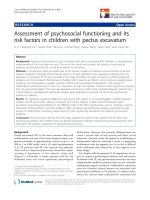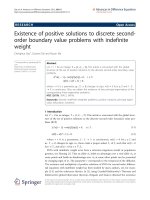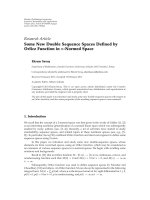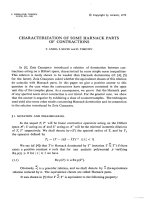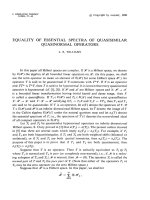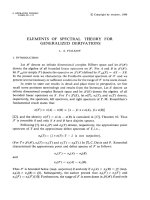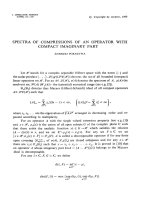Báo cáo toán học: " Subclasses of Uniformly Starlike and Convex Functions Defined by Certain Integral Operator" ppt
Bạn đang xem bản rút gọn của tài liệu. Xem và tải ngay bản đầy đủ của tài liệu tại đây (147.85 KB, 16 trang )
Vietnam Journal of Mathematics 33:3 (2005) 319–334
Subclasses of Uniformly Starlike and
Convex Functions Defined by
Certain Integral Operator
Maslina Darus
1
,AiniJanteng
2
, and Suzeini Abdul Halim
2
1
School of Mathematical Sciences, Faculty of Sciences and Technology,
University Kebangsaan Malaysia 43600 Bangi, Selangor, Malaysia
2
Institute of Mathematical Sciences, University Malaya
50603 Kuala Lumpur, Malaysia
Received July 21, 2004
Revised March 2, 2005
Abstract. In this paper, we consider a class of uniformly starlike functions defined
by certain integral operator. We determine a sufficient condition for a function
f to
be uniformly starlike function that is also necessary when
f has negative coefficients.
Similar results for corresponding subclasses of uniformly convex functions are also
obtained.
1. Introduction
Let S denote the class of functions f which are analytic and univalent in D =
{z :0< |z| < 1} and given by
f(z)=z +
∞
n=2
a
n
z
n
,a
n
≥ 0. (1)
A function f ∈S is called a uniformly starlike function if and only if
Re
zf
(z)
f(z)
≥
zf
(z)
f(z)
− 1
,z∈ D.
We denote this class by S
p
.
A function f ∈S is called a uniformly convex function if and only if
320 Maslina Darus, Aini Janteng, and Suzeini A bdul Halim
Re
1+
zf
(z)
f
(z)
≥
zf
(z)
f
(z)
,z∈ D.
We denote this class by UCV.
Rønning [3] generalized the class S
p
and UCV by introducing a parameter α
in the following way.
Definition 1. [4] Afunctionf ∈S
p
(α), 0 α 1, if f satisfies the analytic
characterization
zf
(z)
f(z)
− 1
Re
zf
(z)
f(z)
− α
and f ∈UCV(α) if and only if zf
∈S
p
(α).
In [1], Bharati et al. obtained coefficient characterization for some subclasses
of S
p
(α)andUCV(α).
Definition 2. [5] Let T be the subclass of S consisting of functions f of the
form
f(z)=z −
∞
n=2
a
n
z
n
,a
n
≥ 0. (2)
Also, Bharati et al. in [1] obtained coefficient characterization for some
subclasses of S
p
(α)andUCV(α)forf ∈T.
Recently, Jung et al. [2] introduced the following one-parameter families of
integral operator for functions f ∈S:
Q
α
β
f(z)=
α + β
β
α
z
β
z
0
1 −
t
z
α−1
t
β−1
f(t)dt, (α>0,β >−1) (3)
and
J
α
f(z)=
α +1
z
α
z
0
t
α−1
f(t)dt, (α>−1). (4)
They showed that
Q
α
β
f(z)=z +
Γ(α + β +1)
Γ(β +1)
∞
n=2
Γ(β + n)
Γ(α + β + n)
a
n
z
n
, (α>0,β >−1) (5)
and
J
α
f(z)=z +
∞
n=2
α +1
α + n
a
n
z
n
, (α>−1). (6)
Uniformly Starlike and Convex Functions Defined by Certain Integral Operator 321
By virtue (5) and (6), we see that
J
α
f(z)=Q
1
α
f(z), (α>−1). (7)
For f ∈T, the operator in (5) and (6) becomes
Q
α
β
f(z)=z −
Γ(α + β +1)
Γ(β +1)
∞
n=2
Γ(β + n)
Γ(α + β + n)
a
n
z
n
, (α>0,β >−1) (8)
and
J
α
f(z)=z −
∞
n=2
α +1
α + n
a
n
z
n
, (α>−1). (9)
Using equations (3) and (4), we introduce the following new subclasses of S
p
(α).
Definition 3. Let T Q(α, β, σ),α>0,β > −1 and 0 σ 1 be the class of
functions f ∈T satisfying the condition
z(Q
α
β
f(z))
Q
α
β
f(z)
− 1
Re
z(Q
α
β
f(z))
Q
α
β
f(z)
− σ, z ∈ D (10)
where Q
α
β
f is defined as in (3).
Definition 4. Let T J(α, σ),α>−1 and 0 σ 1 be the class of functions
f ∈T satisfying the condition
z(J
α
f(z))
J
α
f(z)
− 1
Re
z(J
α
f(z))
J
α
f(z)
− σ, z ∈ D (11)
where J
α
f is defined as in (4).
2. Properties of T Q(α, β, σ)
In this section, we give some results for T Q(α, β, σ). We first state a preliminary
lemma, required for proving our result.
Lemma 1. If Q
α
β
f ∈T then
Γ(α + β +1)
Γ(β +1)
∞
n=2
Γ(β + n)
Γ(α + β + n)
na
n
≤ 1.
Proof. Suppose on the contrary that
Γ(α+β+1)
Γ(β+1)
∞
n=2
Γ(β+n)
Γ(α+β+n)
na
n
> 1. We can
write
Γ(α + β +1)
Γ(β +1)
∞
n=2
Γ(β + n)
Γ(α + β + n)
na
n
=1+ε, (ε>0).
Then there exists an integer N such that
322 Maslina Darus, Aini Janteng, and Suzeini A bdul Halim
Γ(α + β +1)
Γ(β +1)
N
n=2
Γ(β + n)
Γ(α + β + n)
na
n
> 1+
ε
2
.
For
1
1+
ε
2
1
N −1
<z<1, we have
(Q
α
β
f(z))
=1−
Γ(α + β +1)
Γ(β +1)
∞
n=2
Γ(β + n)
Γ(α + β + n)
na
n
z
n−1
1 −
Γ(α + β +1)
Γ(β +1)
N
n=2
Γ(β + n)
Γ(α + β + n)
na
n
z
n−1
1 −
Γ(α + β +1)
Γ(β +1)
z
N−1
N
n=2
Γ(β + n)
Γ(α + β + n)
na
n
< 1 − z
N−1
1+
ε
2
< 0.
Since (Q
α
β
f(0))
=1> 0, there exists a real number z
0
, 0 <z
0
<
1
1+
ε
2
1
N −1
,
such that (Q
α
β
f(z
0
))
= 0. Hence Q
α
β
f is not univalent.
Theorem 1. Let the functions f ∈T.Then
Γ(α + β +1)
Γ(β +1)
∞
n=2
Γ(β + n)
Γ(α + β + n)
(2n − 1 − σ)a
n
1 − σ (12)
for some α>0,β >−1 and 0 σ 1 if and only if f ∈TQ(α, β, σ).
Proof. First, we have
z(Q
α
β
f(z))
Q
α
β
f(z)
− 1
− Re
z(Q
α
β
f(z))
Q
α
β
f(z)
− 1
2
z(Q
α
β
f(z))
Q
α
β
f(z)
− 1
Γ(α+β+1)
Γ(β+1)
∞
n=2
Γ(β+n)
Γ(α+β+n)
2(n − 1)|a
n
||z|
n−1
1 −
Γ(α+β+1)
Γ(β+1)
∞
n=2
Γ(β+n)
Γ(α+β+n)
|a
n
||z|
n−1
Γ(α+β+1)
Γ(β+1)
∞
n=2
Γ(β+n)
Γ(α+β+n)
2(n − 1)a
n
1 −
Γ(α+β+1)
Γ(β+1)
∞
n=2
Γ(β+n)
Γ(α+β+n)
a
n
,
where
1 −
Γ(α + β +1)
Γ(β +1)
∞
n=2
Γ(β + n)
Γ(α + β + n)
|a
n
| > 0
by Lemma 1. The above expression is bounded by 1 − σ if and only if (12) is
satisfied. Consequently, we can write
z(Q
α
β
f(z))
Q
α
β
f(z)
− 1
− Re
z(Q
α
β
f(z))
Q
α
β
f(z)
− 1
1 − σ
Uniformly Starlike and Convex Functions Defined by Certain Integral Operator 323
which is equivalent to (10).
Conversely, if f ∈TQ(α, β, σ)andz is real, then Definition 3 yields
1 −
Γ(α+β+1)
Γ(β+1)
∞
n=2
Γ(β+n)
Γ(α+β+n)
na
n
z
n−1
1 −
Γ(α+β+1)
Γ(β+1)
∞
n=2
Γ(β+n)
Γ(α+β+n)
a
n
z
n−1
− σ
≥
Γ(α+β+1)
Γ(β+1)
∞
n=2
Γ(β+n)
Γ(α+β+n)
(n − 1)a
n
z
n−1
1 −
Γ(α+β+1)
Γ(β+1)
∞
n=2
Γ(β+n)
Γ(α+β+n)
a
n
z
n−1
.
Let z → 1
−
along the real axis, then we get
1 −
Γ(α+β+1)
Γ(β+1)
∞
n=2
Γ(β+n)
Γ(α+β+n)
na
n
1 −
Γ(α+β+1)
Γ(β+1)
∞
n=2
Γ(β+n)
Γ(α+β+n)
a
n
−
Γ(α+β+1)
Γ(β+1)
∞
n=2
Γ(β+n)
Γ(α+β+n)
(n − 1)a
n
1 −
Γ(α+β+1)
Γ(β+1)
∞
n=2
Γ(β+n)
Γ(α+β+n)
a
n
≥ σ
or
1 −
Γ(α + β +1)
Γ(β +1)
∞
n=2
Γ(β + n)
Γ(α + β + n)
(2n − 1)a
n
≥ σ
1 −
Γ(α + β +1)
Γ(β +1)
∞
n=2
Γ(β + n)
Γ(α + β + n)
a
n
which gives the required result.
Our assertion in Theorem 1 is sharp, for functions of the form
F
n
(z)=Q
α
β
f
n
(z)=z−
Γ(β +1)
Γ(α + β +1)
Γ(α + β + n)
Γ(β + n)
1 − σ
2n − 1 − σ
z
n
,n≥ 2 (13)
whichbelongtotheclassT Q(α, β, σ).
Corollary 1. If f ∈TQ(α, β, σ) then
a
n
Γ(β +1)
Γ(α + β +1)
Γ(α + β + n)
Γ(β + n)
1 − σ
2n − 1 − σ
,n≥ 2. (14)
Proof. Since f ∈TQ(α, β, σ), Theorem 1 gives
Γ(α + β +1)
Γ(β +1)
∞
n=2
Γ(β + n)
Γ(α + β + n)
(2n − 1 − σ)a
n
1 − σ.
Next, note that
Γ(α + β +1)
Γ(β +1)
Γ(β + n)
Γ(α + β + n)
(2n − 1 − σ)a
n
Γ(α + β +1)
Γ(β +1)
∞
n=2
Γ(β + n)
Γ(α + β + n)
(2n − 1 − σ)a
n
.
Therefore
a
n
Γ(β +1)
Γ(α + β +1)
Γ(α + β + n)
Γ(β + n)
1 − σ
2n − 1 − σ
,n≥ 2.
324 Maslina Darus, Aini Janteng, and Suzeini A bdul Halim
Corollary 2. If f ∈TQ(α, β, σ) and |z| = r<1,then
(i) |Q
α
β
f(z)| r +
1 − σ
3 − σ
r
2
(ii) |Q
α
β
f(z)|≥r −
1 − σ
3 − σ
r
2
.
The results are sharp.
Proof. First, it is obvious that
Γ(α + β +1)
Γ(β +1)
Γ(β +2)
Γ(α + β +2)
(3 − σ)
∞
n=2
a
n
Γ(α + β +1)
Γ(β +1)
∞
n=2
Γ(β + n)
Γ(α + β + n)
(2n − 1 − σ)a
n
and as f ∈TQ(α, β, σ), using the inequality in Theorem 1 yields
∞
n=2
a
n
Γ(β +1)
Γ(α + β +1)
Γ(α + β +2)
Γ(β +2)
1 − σ
3 − σ
. (15)
From (8) with |z| = r(r<1), we have
|Q
α
β
f(z)| r +
Γ(α + β +1)
Γ(β +1)
∞
n=2
Γ(β + n)
Γ(α + β + n)
a
n
r
n
r +
Γ(α + β +1)
Γ(β +1)
Γ(β +2)
Γ(α + β +2)
∞
n=2
a
n
r
2
and
|Q
α
β
f(z)|≥r −
Γ(α + β +1)
Γ(β +1)
∞
n=2
Γ(β + n)
Γ(α + β + n)
a
n
r
n
≥ r −
Γ(α + β +1)
Γ(β +1)
Γ(β +2)
Γ(α + β +2)
∞
n=2
a
n
r
2
.
Finally, using (15) in the above inequalities gives us both results (i) and (ii).
We note that (i) and (ii) are sharp for the following function
Q
α
β
f
2
(z)=z −
Γ(β +1)
Γ(α + β +1)
Γ(α + β +2)
Γ(β +2)
1 − σ
3 − σ
z
2
at z = ±ir, ±r.
Definition 5. Let T Q(α, β, σ, γ) be the class of functions f ∈T satisfying the
condition
Re
z(Q
α
β
f(z))
Q
α
β
f(z)
≥ σ
z(Q
α
β
f(z))
Q
α
β
f(z)
−1
+γ, α > 0,β>−1, 0 σ 1, 0 γ 1
(16)
where Q
α
β
f is defined as in (3).
We write T Q(α, β, 1,γ)=T Q(α, β, γ).
Uniformly Starlike and Convex Functions Defined by Certain Integral Operator 325
Theorem 2. Let the functions f ∈T.Afunctionf ∈TQ(α, β, σ, γ) for some
α>0,β >−1, 0 σ 1 and 0 γ 1 if and only if
Γ(α + β +1)
Γ(β +1)
∞
n=2
Γ(β + n)
Γ(α + β + n)
[n(1 + σ) − (σ + γ)]a
n
1 − γ. (17)
Proof. In view of Definition 5, it suffices to show that
σ
z(Q
α
β
f(z))
Q
α
β
f(z)
− 1
Re
z(Q
α
β
f(z))
Q
α
β
f(z)
− γ. (18)
The condition (18) is equivalent to
σ
z(Q
α
β
f(z))
Q
α
β
f(z)
− 1
− Re
z(Q
α
β
f(z))
Q
α
β
f(z)
− 1
1 − γ.
Then
σ
z(Q
α
β
f(z))
Q
α
β
f(z)
− 1
− Re
z(Q
α
β
f(z))
Q
α
β
f(z)
− 1
(σ +1)
z(Q
α
β
f(z))
Q
α
β
f(z)
− 1
Γ(α+β+1)
Γ(β+1)
∞
n=2
Γ(β+n)
Γ(α+β+n)
(σ +1)(n − 1)|a
n
||z|
n−1
1 −
Γ(α+β+1)
Γ(β+1)
∞
n=2
Γ(β+n)
Γ(α+β+n)
|a
n
||z|
n−1
Γ(α+β+1)
Γ(β+1)
∞
n=2
Γ(β+n)
Γ(α+β+n)
(σ +1)(n − 1)a
n
1 −
Γ(α+β+1)
Γ(β+1)
∞
n=2
Γ(β+n)
Γ(α+β+n)
a
n
.
The above expression is bounded by 1 − γ if and only if (17) is satisfied.
Conversely, if f ∈TQ(α, β, σ, γ)andz is real, we get
1 −
Γ(α+β+1)
Γ(β+1)
∞
n=2
Γ(β+n)
Γ(α+β+n)
na
n
z
n−1
1 −
Γ(α+β+1)
Γ(β+1)
∞
n=2
Γ(β+n)
Γ(α+β+n)
a
n
z
n−1
≥ σ
Γ(α+β+1)
Γ(β+1)
∞
n=2
Γ(β+n)
Γ(α+β+n)
(n − 1)a
n
z
n−1
1 −
Γ(α+β+1)
Γ(β+1)
∞
n=2
Γ(β+n)
Γ(α+β+n)
a
n
z
n−1
+ γ.
Let z → 1
−
along the real axis, which gives
1 −
Γ(α+β+1)
Γ(β+1)
∞
n=2
Γ(β+n)
Γ(α+β+n)
na
n
1 −
Γ(α+β+1)
Γ(β+1)
∞
n=2
Γ(β+n)
Γ(α+β+n)
a
n
≥ σ
Γ(α+β+1)
Γ(β+1)
∞
n=2
Γ(β+n)
Γ(α+β+n)
(n − 1)a
n
1 −
Γ(α+β+1)
Γ(β+1)
∞
n=2
Γ(β+n)
Γ(α+β+n)
a
n
+ γ,
that is equivalent to
1 −
Γ(α + β +1)
Γ(β +1)
∞
n=2
Γ(β + n)
Γ(α + β + n)
(n + σn − σ)a
n
≥ γ
1 −
Γ(α + β +1)
Γ(β +1)
∞
n=2
Γ(β + n)
Γ(α + β + n)
a
n
326 Maslina Darus, Aini Janteng, and Suzeini A bdul Halim
and gives the required result. Then, the proof is complete.
Our assertion in Theorem 2 is sharp for functions of the form
F
n
(z)=Q
α
β
f
n
(z)=z−
Γ(β +1)
Γ(α + β +1)
Γ(α + β + n)
Γ(β + n)
1 − γ
n(1 + σ) − (σ + γ)
z
n
,n≥ 2
(19)
whichbelongtotheclassT Q(α, β, σ, γ).
Corollary 3. If f ∈TQ(α, β, σ, γ) then
a
n
Γ(β +1)
Γ(α + β +1)
Γ(α + β + n)
Γ(β + n)
1 − γ
n(1 + σ) − (σ + γ)
,n≥ 2. (20)
Proof. Since f ∈TQ(α, β, σ, γ), Theorem 2 yields
Γ(α + β +1)
Γ(β +1)
∞
n=2
Γ(β + n)
Γ(α + β + n)
[n(1 + σ) − (σ + γ)]a
n
1 − γ.
Next, note that
Γ(α + β +1)
Γ(β +1)
Γ(β + n)
Γ(α + β + n)
[n(1 + σ) − (σ + γ)]a
n
Γ(α + β +1)
Γ(β +1)
∞
n=2
Γ(β + n)
Γ(α + β + n)
[n(1 + σ) − (σ + γ)]a
n
.
Therefore
a
n
Γ(β +1)
Γ(α + β +1)
Γ(α + β + n)
Γ(β + n)
1 − γ
n(1 + σ) − (σ + γ)
,n≥ 2.
Corollary 4. If f ∈TQ(α, β, σ, γ) and |z| = r<1,then
(i) |Q
α
β
f(z)| r +
1 − γ
2+σ − γ
r
2
,
(ii) |Q
α
β
f(z)|≥r −
1 − γ
2+σ − γ
r
2
.
Proof. First, it is obvious that
Γ(α + β +1)
Γ(β +1)
Γ(β +2)
Γ(α + β +2)
(2 + σ − γ)
∞
n=2
a
n
Γ(α + β +1)
Γ(β +1)
∞
n=2
Γ(β + n)
Γ(α + β + n)
[n(1 + σ) − (σ + γ)]a
n
,
and as f ∈TQ(α, β, σ, γ), using the inequality in Theorem 2 yields
∞
n=2
a
n
Γ(β +1)
Γ(α + β +1)
Γ(α + β +2)
Γ(β +2)
1 − γ
2+σ − γ
. (21)
From (8) with |z| = r(r<1), we have
Uniformly Starlike and Convex Functions Defined by Certain Integral Operator 327
|Q
α
β
f(z)| r +
Γ(α + β +1)
Γ(β +1)
∞
n=2
Γ(β + n)
Γ(α + β + n)
a
n
r
n
r +
Γ(α + β +1)
Γ(β +1)
Γ(β +2)
Γ(α + β +2)
∞
n=2
a
n
r
2
and
|Q
α
β
f(z)|≥r −
Γ(α + β +1)
Γ(β +1)
∞
n=2
Γ(β + n)
Γ(α + β + n)
a
n
r
n
≥ r −
Γ(α + β +1)
Γ(β +1)
Γ(β +2)
Γ(α + β +2)
∞
n=2
a
n
r
2
.
Finally, using (21) in the above inequalities gives us both results (i) and (ii).
We note that (i) and (ii) are sharp for the following function
Q
α
β
f
2
(z)=z −
Γ(β +1)
Γ(α + β +1)
Γ(α + β +2)
Γ(β +2)
1 − γ
2+σ − γ
z
2
at z = ±ir, ±r.
Remark 1. By taking β = α and α = 1 in (8), analogous results for T J(α, σ)
are also obtained.
3. Properties of UCVQ
T
(α, β, σ)
Now, let us draw our attention to the following new subclasses of UCV(α)and
find their coefficient criterion.
Definition 6. Let UCVQ
T
(α, β, σ),α>0,β > −1 and 0 σ 1 be the class
of functions f ∈T which satisfy the condition
z(Q
α
β
f(z))
(Q
α
β
f(z))
Re
1+
z(Q
α
β
f(z))
(Q
α
β
f(z))
− σ
,z∈ D (22)
where Q
α
β
f is defined as in (3).
Definition 7. Let UCVJ
T
(α, σ),α>−1 and 0 σ 1 be the class of functions
f ∈T which satisfy the condition
z(J
α
f(z))
(J
α
f(z))
Re
1+
z(J
α
f(z))
(J
α
f(z))
− σ
,z∈ D, (23)
where J
α
f is defined as in (4).
Next,wegivesomeresultsforUCVQ
T
(α, β, σ) as the following.
Theorem 3. Let the functions f ∈T.Then
328 Maslina Darus, Aini Janteng, and Suzeini A bdul Halim
Γ(α + β +1)
Γ(β +1)
∞
n=2
Γ(β + n)
Γ(α + β + n)
(2n − 1 − σ)na
n
1 − σ (24)
for some α>0,β >−1 and 0 σ 1 if and only if f ∈UCVQ
T
(α, β, σ).
Proof. First, we consider
z(Q
α
β
f(z))
(Q
α
β
f(z))
− Re
z(Q
α
β
f(z))
(Q
α
β
f(z))
2
z(Q
α
β
f(z))
(Q
α
β
f(z))
Γ(α+β+1)
Γ(β+1)
∞
n=2
Γ(β+n)
Γ(α+β+n)
2n(n − 1)|a
n
||z|
n−1
1 −
Γ(α+β+1)
Γ(β+1)
∞
n=2
Γ(β+n)
Γ(α+β+n)
n|a
n
||z|
n−1
Γ(α+β+1)
Γ(β+1)
∞
n=2
Γ(β+n)
Γ(α+β+n)
2n(n − 1)a
n
1 −
Γ(α+β+1)
Γ(β+1)
∞
n=2
Γ(β+n)
Γ(α+β+n)
na
n
,
where 1 −
Γ(α+β+1)
Γ(β+1)
∞
n=2
Γ(β+n)
Γ(α+β+n)
n|a
n
| > 0 by getting use of Lemma 1.
The above expression is bounded by 1 − σ if and only if (24) is satisfied.
Consequently, we can write
z(Q
α
β
f(z))
(Q
α
β
f(z))
Re
z(Q
α
β
f(z))
(Q
α
β
f(z))
+1− σ.
which is equivalent to (22).
Conversely, if f ∈UCVQ
T
(α, β, σ)andz is real, then Definition 6 yields
1 −
Γ(α+β+1)
Γ(β+1)
∞
n=2
Γ(β+n)
Γ(α+β+n)
n(n − 1)a
n
z
n−1
1 −
Γ(α+β+1)
Γ(β+1)
∞
n=2
Γ(β+n)
Γ(α+β+n)
na
n
z
n−1
− σ
≥
Γ(α+β+1)
Γ(β+1)
∞
n=2
Γ(β+n)
Γ(α+β+n)
n(n − 1)a
n
z
n−1
1 −
Γ(α+β+1)
Γ(β+1)
∞
n=2
Γ(β+n)
Γ(α+β+n)
na
n
z
n−1
.
Let z → 1
−
along the real axis, then we get
(1 − σ) ≥
Γ(α+β+1)
Γ(β+1)
∞
n=2
Γ(β+n)
Γ(α+β+n)
2n(n − 1)a
n
1 −
Γ(α+β+1)
Γ(β+1)
∞
n=2
Γ(β+n)
Γ(α+β+n)
na
n
or
(1 − σ)
1 −
Γ(α + β +1)
Γ(β +1)
∞
n=2
Γ(β + n)
Γ(α + β + n)
na
n
≥
Γ(α + β +1)
Γ(β +1)
∞
n=2
Γ(β + n)
Γ(α + β + n)
2n(n − 1)a
n
,
which gives the required result.
Our assertion in Theorem 3 is sharp for functions of the form
Uniformly Starlike and Convex Functions Defined by Certain Integral Operator 329
F
n
(z)=Q
α
β
f
n
(z)=z −
Γ(β +1)
Γ(α + β +1)
Γ(α + β + n)
Γ(β + n)
1 − σ
n(2n − 1 − σ)
z
n
,n≥ 2
(25)
whichbelongtotheclassUCVQ
T
(α, β, σ).
Corollary 5. If f ∈UCVQ
T
(α, β, σ) then
a
n
Γ(β +1)
Γ(α + β +1)
Γ(α + β + n)
Γ(β + n)
1 − σ
n(2n − 1 − σ)
,n≥ 2. (26)
Proof. Since f ∈UCVQ
T
(α, β, σ), Theorem 3 gives
Γ(α + β +1)
Γ(β +1)
∞
n=2
Γ(β + n)
Γ(α + β + n)
n(2n − 1 − σ)a
n
1 − σ.
Next, note that
Γ(α + β +1)
Γ(β +1)
Γ(β + n)
Γ(α + β + n)
n(2n − 1 − σ)a
n
Γ(α + β +1)
Γ(β +1)
∞
n=2
Γ(β + n)
Γ(α + β + n)
n(2n − 1 − σ)a
n
.
Therefore
a
n
Γ(β +1)
Γ(α + β +1)
Γ(α + β + n)
Γ(β + n)
1 − σ
n(2n − 1 − σ)
,n≥ 2.
Corollary 6. If f ∈UCVQ
T
(α, β, σ) and |z| = r<1,then
(i) |Q
α
β
f(z)| r +
1 − σ
2(3 − σ)
r
2
,
(ii) |Q
α
β
f(z)|≥r −
1 − σ
2(3 − σ)
r
2
.
Proof. First, it is obvious that
Γ(α + β +1)
Γ(β +1)
Γ(β +2)
Γ(α + β +2)
2(3 − σ)
∞
n=2
a
n
Γ(α + β +1)
Γ(β +1)
∞
n=2
Γ(β + n)
Γ(α + β + n)
n(2n − 1 − σ)a
n
,
and as f ∈UCVQ
T
(α, β, σ), using the inequality in Theorem 3 yields
∞
n=2
a
n
Γ(β +1)
Γ(α + β +1)
Γ(α + β +2)
Γ(β +2)
1 − σ
2(3 − σ)
. (27)
From (8) with |z| = r(r<1), we have
|Q
α
β
f(z)| r +
Γ(α + β +1)
Γ(β +1)
∞
n=2
Γ(β + n)
Γ(α + β + n)
a
n
r
n
r +
Γ(α + β +1)
Γ(β +1)
Γ(β +2)
Γ(α + β +2)
∞
n=2
a
n
r
2
330 Maslina Darus, Aini Janteng, and Suzeini A bdul Halim
and
|Q
α
β
f(z)|≥r −
Γ(α + β +1)
Γ(β +1)
∞
n=2
Γ(β + n)
Γ(α + β + n)
a
n
r
n
≥ r −
Γ(α + β +1)
Γ(β +1)
Γ(β +2)
Γ(α + β +2)
∞
n=2
a
n
r
2
.
Finally, using (27) in the above inequalities gives us both results (i) and (ii).
We note that (i) and (ii) are sharp for the following function
Q
α
β
f
2
(z)=z −
Γ(β +1)
Γ(α + β +1)
Γ(α + β +2)
Γ(β +2)
1 − σ
2(3 − σ)
z
2
at z = ±ir, ±r.
Definition 8. Let UCVQ
T
(α, β, σ, γ) be the class of functions f ∈T satisfying
the condition
Re
1+
z(Q
α
β
f(z))
(Q
α
β
f(z))
≥ σ
z(Q
α
β
f(z))
(Q
α
β
f(z))
+γ, α > 0,β >−1, 0 σ 1, 0 γ 1.
(28)
where Q
α
β
f is defined as in (3).
We write UCVQ
T
(α, β, 1,γ)=UCVQ
T
(α, β, γ).
Theorem 4. Let the functions f ∈T.Afunctionf ∈UCVQ
T
(α, β, σ, γ) for
some α>0,β >−1, 0 σ 1 and 0 γ 1 if and only if
Γ(α + β +1)
Γ(β +1)
∞
n=2
Γ(β + n)
Γ(α + β + n)
n[n(1 + σ) − (σ + γ)]a
n
1 − γ. (29)
Proof. In view of Definition 8, it suffices to show that
σ
z(Q
α
β
f(z))
(Q
α
β
f(z))
Re
z(Q
α
β
f(z))
(Q
α
β
f(z))
+1
− γ. (30)
Then, we have
σ
z(Q
α
β
f(z))
(Q
α
β
f(z))
− Re
z(Q
α
β
f(z))
(Q
α
β
f(z))
(σ +1)
z(Q
α
β
f(z))
(Q
α
β
f(z))
Γ(α+β+1)
Γ(β+1)
∞
n=2
Γ(β+n)
Γ(α+β+n)
(σ +1)n(n − 1)|a
n
||z|
n−1
1 −
Γ(α+β+1)
Γ(β+1)
∞
n=2
Γ(β+n)
Γ(α+β+n)
n|a
n
||z|
n−1
Γ(α+β+1)
Γ(β+1)
∞
n=2
Γ(β+n)
Γ(α+β+n)
(σ +1)n(n − 1)a
n
1 −
Γ(α+β+1)
Γ(β+1)
∞
n=2
Γ(β+n)
Γ(α+β+n)
na
n
.
Uniformly Starlike and Convex Functions Defined by Certain Integral Operator 331
The above expression is bounded by 1 − γ if and only if (29) is satisfied.
Conversely, if f ∈UCVQ
T
(α, β, σ, γ)andz is real, we get
1 −
Γ(α+β+1)
Γ(β+1)
∞
n=2
Γ(β+n)
Γ(α+β+n)
n(n − 1)a
n
z
n−1
1 −
Γ(α+β+1)
Γ(β+1)
∞
n=2
Γ(β+n)
Γ(α+β+n)
na
n
z
n−1
≥ σ
Γ(α+β+1)
Γ(β+1)
∞
n=2
Γ(β+n)
Γ(α+β+n)
n(n − 1)a
n
z
n−1
1 −
Γ(α+β+1)
Γ(β+1)
∞
n=2
Γ(β+n)
Γ(α+β+n)n
a
n
z
n−1
+ γ.
Let z → 1
−
along the real axis, which gives
(1 − γ) ≥ (1 + σ)
Γ(α+β+1)
Γ(β+1)
∞
n=2
Γ(β+n)
Γ(α+β+n)
n(n − 1)a
n
1 −
Γ(α+β+1)
Γ(β+1)
∞
n=2
Γ(β+n)
Γ(α+β+n)
na
n
,
and equivalent to
(1 − γ)
1 −
Γ(α + β +1)
Γ(β +1)
∞
n=2
Γ(β + n)
Γ(α + β + n)
na
n
≥ (1 + σ)
Γ(α + β +1)
Γ(β +1)
∞
n=2
Γ(β + n)
Γ(α + β + n)
n(n − 1)a
n
.
Thus, the proof is complete.
Our assertion in Theorem 4 is sharp for functions of the form
F
n
(z)=Q
α
β
f
n
(z)=z−
Γ(β +1)
Γ(α + β +1)
Γ(α + β + n)
Γ(β + n)
1 − γ
n[n(1 + σ) − (σ + γ)]
z
n
,n≥ 2
(31)
whichbelongtotheclassUCVQ
T
(α, β, σ, γ).
Corollary 7. If f ∈UCVQ
T
(α, β, σ, γ) then
a
n
Γ(β +1)
Γ(α + β +1)
Γ(α + β + n)
Γ(β + n)
1 − γ
n[n(1 + σ) − (σ + γ)]
,n≥ 2. (32)
Proof. Since f ∈UCVQ
T
(α, β, σ, γ), Theorem 4 gives
Γ(α + β +1)
Γ(β +1)
∞
n=2
Γ(β + n)
Γ(α + β + n)
n[n(1 + σ) − (σ + γ)]a
n
1 − γ.
Next, note that
Γ(α + β +1)
Γ(β +1)
Γ(β + n)
Γ(α + β + n)
n[n(1 + σ) − (σ + γ)]a
n
Γ(α + β +1)
Γ(β +1)
∞
n=2
Γ(β + n)
Γ(α + β + n)
n[n(1 + σ) − (σ + γ)]a
n
.
332 Maslina Darus, Aini Janteng, and Suzeini A bdul Halim
Therefore
a
n
Γ(β +1)
Γ(α + β +1)
Γ(α + β + n)
Γ(β + n)
1 − γ
n[n(1 + σ) − (σ + γ)]
,n≥ 2.
Corollary 8. If f ∈UCVQ
T
(α, β, σ, γ) and |z| = r<1,then
(i) |Q
α
β
f(z)| r +
1−γ
2(2+σ−γ)
r
2
(ii) |Q
α
β
f(z)|≥r −
1−γ
2(2+σ−γ)
r
2
.
The results are sharp.
Proof. First, it is obvious that
Γ(α + β +1)
Γ(β +1)
Γ(β +2)
Γ(α + β +2)
2(2 + σ − γ)a
n
Γ(α + β +1)
Γ(β +1)
∞
n=2
Γ(β + n)
Γ(α + β + n)
n[n(1 + σ) − (σ + γ)]a
n
,
and as f ∈UCVQ
T
(α, β, σ, γ), using the inequality in Theorem 4 yields
∞
n=2
a
n
Γ(β +1)
Γ(α + β +1)
Γ(α + β +2)
Γ(β +2)
1 − γ
2(2 + σ − γ)
. (33)
From (8) with |z| = r(r<1), we have
|Q
α
β
f(z)| r +
Γ(α + β +1)
Γ(β +1)
∞
n=2
Γ(β + n)
Γ(α + β + n)
a
n
r
n
r +
Γ(α + β +1)
Γ(β +1)
Γ(β +2)
Γ(α + β +2)
∞
n=2
a
n
r
2
and
|Q
α
β
f(z)|≥r −
Γ(α + β +1)
Γ(β +1)
∞
n=2
Γ(β + n)
Γ(α + β + n)
a
n
r
n
≥ r −
Γ(α + β +1)
Γ(β +1)
Γ(β +2)
Γ(α + β +2)
∞
n=2
a
n
r
2
.
Finally, using (33) in the above inequalities gives us both results (i) and (ii).
We note that (i) and (ii) are sharp for the following function
Q
α
β
f
2
(z)=z −
Γ(β +1)
Γ(α + β +1)
Γ(α + β +2)
Γ(β +2)
1 − γ
2(2 + σ − γ)
z
2
at z = ±ir, ±r.
Definition 9. Let
CQ
T
(α, β, σ)
=
f ∈T;
z(Q
α
β
f(z))
(Q
α
β
f(z))
+1− σ
Re
z(Q
α
β
f(z))
(Q
α
β
f(z))
+1+σ
,α>0,β>−1,σ>0
Uniformly Starlike and Convex Functions Defined by Certain Integral Operator 333
Theorem 5. Let f ∈T.Thenf ∈CQ
T
(α, β, σ) if and only if
Γ(α + β +1)
Γ(β +1)
∞
n=2
Γ(β + n)
Γ(α + β + n)
n(n − 1+σ)a
n
σ. (34)
Proof. By Definition 9, it is sufficient to prove the inequality
1+
z(Q
α
β
f(z))
(Q
α
β
f(z))
− σ
Re
z(Q
α
β
f(z))
(Q
α
β
f(z))
+1+σ
or equivalently
1+
z(Q
α
β
f(z))
(Q
α
β
f(z))
− σ
− Re
1+
z(Q
α
β
f(z))
(Q
α
β
f(z))
− σ
2σ.
We have
1+
z(Q
α
β
f(z))
(Q
α
β
f(z))
− σ
− Re
1+
z(Q
α
β
f(z))
(Q
α
β
f(z))
− σ
2
1+
z(Q
α
β
f(z))
(Q
α
β
f(z))
− σ
2
Γ(α+β+1)
Γ(β+1)
∞
n=2
Γ(β+n)
Γ(α+β+n)
n(n − 1)|a
n
||z|
n−1
1 −
Γ(α+β+1)
Γ(β+1)
∞
n=2
Γ(β+n)
Γ(α+β+n)
n|a
n
||z|
n−1
+1− σ
2
Γ(α+β+1)
Γ(β+1)
∞
n=2
Γ(β+n)
Γ(α+β+n)
n(n − 1)a
n
1 −
Γ(α+β+1)
Γ(β+1)
∞
n=2
Γ(β+n)
Γ(α+β+n)
na
n
+1− σ
.
The above expression is bounded by 2σ if and only if (34) is satisfied.
Conversely, if f ∈CQ
T
(α, β, σ)andz is real, we get
1 −
Γ(α+β+1)
Γ(β+1)
∞
n=2
Γ(β+n)
Γ(α+β+n)
n(n − 1)a
n
z
n−1
1 −
Γ(α+β+1)
Γ(β+1)
∞
n=2
Γ(β+n)
Γ(α+β+n)
na
n
z
n−1
≥
Γ(α+β+1)
Γ(β+1)
∞
n=2
Γ(β+n)
Γ(α+β+n)
n(n − 1)a
n
z
n−1
1 −
Γ(α+β+1)
Γ(β+1)
∞
n=2
Γ(β+n)
Γ(α+β+n)
na
n
z
n−1
+1− 2σ.
Let z → 1
−
along the real axis, which gives
Γ(α+β+1)
Γ(β+1)
∞
n=2
Γ(β+n)
Γ(α+β+n)
n(n − 1)a
n
1 −
Γ(α+β+1)
Γ(β+1)
∞
n=2
Γ(β+n)
Γ(α+β+n)
na
n
σ
and gives the required result.
Corollary 9. If f ∈CQ
T
(α, β, σ) and |z| = r<1, then for 0 <σ 1
(i) |Q
α
β
f(z)| r +
σ
2(1+σ)
r
2
,
(i) |Q
α
β
f(z)|≥r −
σ
2(1+σ)
r
2
.
Proof. First, it is obvious that
334 Maslina Darus, Aini Janteng, and Suzeini A bdul Halim
Γ(α + β +1)
Γ(β +1)
Γ(β +2)
Γ(α + β +2)
2(1 + σ)a
n
Γ(α + β +1)
Γ(β +1)
∞
n=2
Γ(β + n)
Γ(α + β + n)
n(n − 1+σ)a
n
,
and as f ∈CQ
T
(α, β, σ), using the inequality in Theorem 5 yields
∞
n=2
a
n
Γ(β +1)
Γ(α + β +1)
Γ(α + β +2)
Γ(β +2)
σ
2(1 + σ)
. (35)
From (8) with |z| = r(r<1), we have
Q
α
β
f(z)| r +
Γ(α + β +1)
Γ(β +1)
∞
n=2
Γ(β + n)
Γ(α + β + n)
a
n
r
n
r +
Γ(α + β +1)
Γ(β +1)
Γ(β +2)
Γ(α + β +2)
∞
n=2
a
n
r
2
and
|Q
α
β
f(z)|≥r −
Γ(α + β +1)
Γ(β +1)
∞
n=2
Γ(β + n)
Γ(α + β + n)
a
n
r
n
≥ r −
Γ(α + β +1)
Γ(β +1)
Γ(β +2)
Γ(α + β +2)
∞
n=2
a
n
r
2
.
Finally, using (35) in the above inequalities gives us both results (i) and (ii).
We note that (i) and (ii) are sharp for the following function
Q
α
β
f
2
(z)=z −
Γ(β +1)
Γ(α + β +1)
Γ(α + β +2)
Γ(β +2)
σ
2(1 + σ)
z
2
at z = ±ir, ±r.
Remark 2. By taking β = α and α = 1 in (8), analogous results for UCVJ
T
(α, σ)
are also obtained.
References
1. R. Bharati, R. Parvatham, and A. Swaminathan, On subclasses of uniformly
convex functions and corresponding class of starlike functions, Tamkang J. Math.
28 (1997) 17–33.
2. I. B. Jung, Y. C. Kim, and H. M. Srivastava, The Hardy space of analytic func-
tions associated with certain one-parameter families of integral operators, J.
Math. Anal. Appl. 176 (1993) 138–147.
3. F. Rønning, Uniformly convex functions and a corresponding class of starlike
functions, Proc.Amer.Math.Soc.118 (1993) 189–196.
4. F. Rønning, Integral representations for bounded starlike functions, Annales
Polon. Math., 60 (1995) 289–297.
5. H. Silverman, Univalent functions with negative coefficients, Proc. Amer. Math.
Soc. 51 (1975) 109–116.

